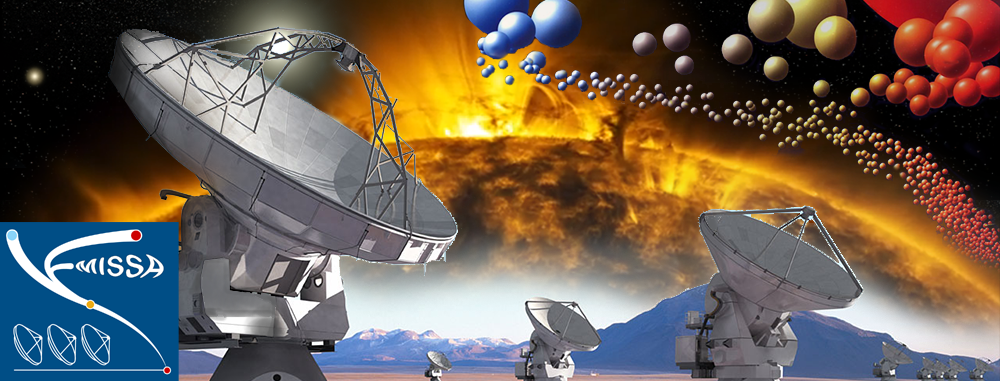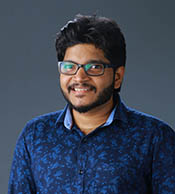The EMISSA Project is led by Associate Professor Sven Wedemeyer. The project runs to September 2023. At the EMISSA project he will study the activity and dynamics of stellar outer atmospheres in Sun-like stars and model it.
A strong background
Atul Mohan is Indian and he took his PhD in Astrophysics in 2019 at the National Centre for Radio Astrophysics, Tata Institute of Fundamental Research in Pune, India. The Astronomy department runs the world largest telescope array, GMRT. Atul worked in Solar Physics during his PhD.
He did his Bachelor and Masters in Physics at the Indian Institute of Science Education and Research in Thiruvananthapuran, India.
Work focus
Currently I’m studying other Sun-like stars with the Sun as a template to compare and contrast. Though we know our Sun to a fairly good extent with regard to its various outer atmospheric activity, we have no idea how the other stars like our Sun behave,
explains Mohan.
The important basic questions are:
- What are the general characteristics of the outer atmospheres of Sun-like stars?
- Where do our Sun stand in this larger picture: Is it a usual star among these or an exception in any kind?
- What are the indicators/metrics one can define to characterise and classify these stellar atmospheres and their dynamics/activity?
These questions are finally all connected to the question of whether the Sun is an exceptional star which is somehow “ideal” in these metrics, that it could give ample time and energy required, to let life flourish for so long it its nearby rocky planet, the Earth, says Mohan.
A plan to go by
- How do you plan to answer to the main question?
- I aim to image Sun-like stars in millimetre to centimetre wavelength ranges and derive their spectrum which are unavailable currently for most of these stars due to their very faint emission in these bands. But with highly sensitive new generation radio array like ALMA, EVLA etc. this is now possible. Each frequency in this spectral band is uniquely sensitive to the different outer atmospheric layers of Sun-like stars, from the photosphere to the outermost stellar hot layer Corona, acting like a tomographic scanner.

I will make a database of atmospheric thermal structure of sun-like stars using data from all modern highly sensitive radio arrays. The entire available observed information of these stars like its magnetic field, X-ray to optical wavelength emission and specific spectral line emissions, which are indicators of stellar activity and its variations will then be appended to the database to produce a complete library of information for each star. I will work closely with the team in developing models of stellar atmospheres, determine the ones that best fit the catalogued information on each star, and build insights on the physical characteristics and dynamics of their atmospheres.
I will write radio imaging pipelines to analyse the data from new generation radio interferometers and make a database of as many Sun-like stars as possible. I will work towards developing the stellar atmospheric information database and software tools to efficiently retrieve, compare, correlate and plot/represent the information. I will also work closely with the group to find the suitable models/model physical parameters that fit the stars. All these will be done with Sun as a template to compare against.
The choice of RoCS
The RoCS group has a good expertise in stellar atmospheric modelling, mainly the Sun. They have exceptional theoretical expertise in Solar plasma simulations and are world leading in computing resources,
explains Atul. He enjoys being in the growing radio analysis group where he can collaborate with young energetic researchers in building techniques and tools and extract science relevant information from new-age radio data, with experience in working on Solar radio phenomena with a modern radio telescope. He has made knowledge in general of the radio data and can add more telescopes to the arsenal of RoCS apart from ALMA.
- Besides this, and most importantly, I can fill my gaps in theoretical and computational experience by collaborating with everyone here. RoCS gives me a good exposure to international scientific community since it stands tall as a well respected and globally visible institution, says Mohan.
Norway on the bucket-list
Norway has been on Mohan's list as a must visit destination. - Its unique landscape, flora and fauna and above all the aurora has always mesmerised me. Also the fact that this country is at the top of the most happiest and safe ones adds to ones amazement, says Mohan.
He finds the atmosphere positive and people have been very helpful with both academic and non-academic matters. - At the same time they respect your independence and personal space. Professionally, I love this place as I’m swarmed by experts with whom I can easily spark a chat with no hassle, says Mohan.
He is newly married and looks forward to having his wife join him in Oslo. He loves traveling, new cultures and cuisines, and meeting people with varied views on life.
- I would like to attend the Nobel Prize ceremony once. I wish the University had some tickets for this and if they have - I would like to hear more about it, ends Mohan.
